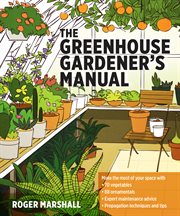Nonfiction
eBook
Details
PUBLISHED
Made available through hoopla
DESCRIPTION
1 online resource
ISBN/ISSN
LANGUAGE
NOTES
"Anyone purchasing a greenhouse should read this book first." -Home Greenhouse Magazine Do you want homegrown tomatoes in the dead of winter? Or to grow succulents and cacti in the coldest parts of the world? All you need is a greenhouse. In The Greenhouse Gardener's Manual, Roger Marshall shares the secrets of successfully growing vegetables, fruits, flowers, and houseplants in a well-maintained greenhouse. You'll learn how to choose the right design, create a healthy environment, use the space for propagation, and maintain the greenhouse year-round. Marshall also includes a plant directory of the 70 best fruits and vegetables and the 88 best ornamental plants for growing in a greenhouse. Greenhouses offer gardeners a way to extend their growing season, a chance to increase their plant palette beyond regional limits, and a place of refuge. With The Greenhouse Gardener's Manual in hand, you can grow inside with confidence! In addition to designing boats, Roger Marshall regularly lectures and gives talks on gardening and greenhouse growing. He writes a monthly blog post for Hartley Greenhouse, and is the former editor of Home Greenhouse. He is also a member of the Garden Writers Association, The American Society of Journalists and Authors, and the Society of Authors (UK). Preface It is early spring, and outdoors the trees are just starting to send out leaves. But in the greenhouse you bite into a fresh, juicy tomato that you have just plucked from a vine. Nearby, key limes and oranges await harvesting, their citrusy aroma wafting through the warm, humid air. Flowers, including fuchsias, orchids, and paperwhites, add their heady fragrance to the mix. These are just some of the pleasures of owning a home greenhouse. And there is more than just the sheer joy of picking produce and flowers out of season that makes a home greenhouse so appealing. A greenhouse can be a warm, inviting place to put chairs or a hammock to relax in, or it can be an addition built onto your house that helps to provide home heating when the weather is frigid. One day after a winter snowstorm in Rhode Island, I brushed the snow off the greenhouse that is attached to my office. Once the sun hit the greenhouse glass, the temperature inside quickly reached 78°F (25°C). Just by opening the connecting office door, I was soon enjoying all that warmth and humidity without turning on a heater. I felt like I had been transported to Florida despite the snowy outdoor landscape. Greenhouses can be used for other purposes as well. You can create a fish-tank system that circulates nutrient-rich water to irrigate an exotic mix of lush tropical plants or hydroponic strawberries. You can store tender plants over the winter months. You can even start a small business propagating and selling specialty plants. The possibilities are limited only by your imagination. As soon as you buy or build a greenhouse you will probably want to know more about keeping your plants growing year-round. I would suggest you join the Hobby Greenhouse Association, whose members use the website and quarterly magazine to keep abreast of news and information in the home greenhouse world. Oh, and I edit the magazine, so I know that it's full of inspiration and practical information, much like this book. The ultimate guide to growing inside A greenhouse can bring you spectacular rewards-if you know how to maximize its potential. In this easy-to-use guide, Roger Marshall covers all the basics-how to choose, heat, irrigate, and maintain your greenhouse-as well how to grow scores of popular plants, including vegetables, herbs, and fruit; ornamentals for flowers and foliage; and collectors' plants such as orchids, bromeliads, cacti, and succulents. You'll also learn propagation techniques, the basics of hydroponics and aquaponics, and the most effective ways of controlling pests and diseases. Don't let that precious space go to waste-fi
Mode of access: World Wide Web







